1、Spring
1.2、优点
- Spring 是一个开源的免费框架(容器)
- Spring 是一个轻量级的、非入侵式的框架!
- 控制反转(IOC),面向切面编程(AOP)
- 支持事务的处理,对框架整合的支持
总结一句话:Spring 是一个轻量级的控制反转和面向切面编程的框架
1.3、组成
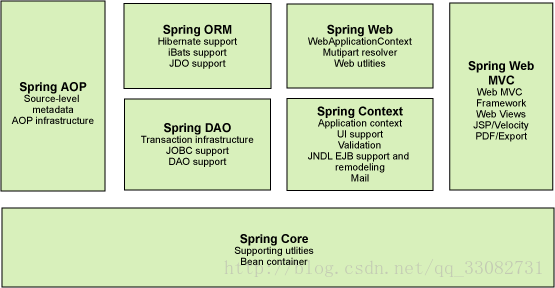
1.4、拓展
- SpringBoot
- 一个快速开发的脚手架
- 基于 SpringBoot 可以快速的开发单个微服务
- 约定大于配置!
- Spring Cloud
- SpringCloud 是基于 SpringBoot 实现的
现在大多数公司都在使用 SpringBoot 进行快速开发,学习 SpringBoot 的前提,需要完全掌握 Spring 及 SpringMVC!承上启下
2、IOC 理论推导
- UserDao 接口
- UserDaoImpl 实现类
- UserService 业务接口
- UserServiceImpl 业务实现类
在我们之前的业务中,用户的需求可能会影响我们原来的代码,我们需要根据用户的需求去修改原代码!如果程序代码量十分大,修改一次的成本代价十分昂贵!
我们使用一个 Set 接口实现:
private UserDao userDao; //利用set进行动态实现值的注入!
public void setUserDao(UserDao userDao)
{
this.userDao=userDao;
}- 之前,程序是主动创建对象!控制权在程序员手上
- 使用 set 之后,程序不在具有主动性,而是被动的接受对象(对扩展开发,对修改关闭)
从本质上解决问题,不需要管理对象的创建,耦合性降低,专注于业务实现,这就是 IOC 的原型。
IOC 本质
IOC 控制反转是一种设计思想,DI(依赖注入) 是实现 IOC 的一种方法。没有 IOC 的程序中,我们使用面向对象编程,对象的创建与对象间的依赖关系完全硬编码在程序中,对象的创建由程序自己控制。控制反转之后将对象的创建转移给第三方,个人理解控制反转就是:获得依赖对象的方式发生转变了。
IOC 是 Spring 框架的核心内容,使用多种方式完美的实现的 Ioc,可以使用 xml 配置,也可以使用注解,新版本的 Spring 也可以零配置实现 IOC(自动装配)。
采用 xml 方式配置 Bean 的时候,Bean 的定义信息和实现是分离的,采用注解的方式可以把两者合为一体。Bean 的定义信息直接以注解的形式在定义在实现类中,从而达到零配置的目的。
控制反转是一种通过描述 xml 或者注解,并通过第三方去生产或获取特定对象的方式。在 Spring 中实现控制反转的是 IOC 容器,其实现方式是依赖注入。
3、HelloSpring
public class Hello {
private String str;
@Override
public String toString() {
return "Hello{" +
"str='" + str + '\'' +
'}';
}
public String getStr() {
return str;
}
public void setStr(String str) {
this.str = str;
}
}
https://docs.spring.io/spring-framework/docs/current/reference/html/core.html#spring-core
<?xml version="1.0" encoding="UTF-8"?>
<beans xmlns="http://www.springframework.org/schema/beans"
xmlns:xsi="http://www.w3.org/2001/XMLSchema-instance"
xsi:schemaLocation="http://www.springframework.org/schema/beans
https://www.springframework.org/schema/beans/spring-beans.xsd">
<bean id="hello" class="com.kuang.pojo.Hello">
<property name="str" value="Hello Spring"/>
<!--
ref:引用Spring容器中创建好的对象
value:引用具体的值,基本数据类型
-->
</bean>
</beans>public class MyTest {
public static void main(String[] args) {
//获取ApplicationContext:拿取Spring的容器
ApplicationContext context = new ClassPathXmlApplicationContext("beans.xml");
//需要什么,就get什么
Hello hello = (Hello) context.getBean("hello");
System.out.println(hello.toString());
}
}- Hello 对象是谁创建的?
- hello 对象是由 Spring 创建的
- Hello 对象的属性是怎么设置的
- hello 对象的属性是由 Spring 容器设置的
上面就用配置文件的形式,实现了控制反转
控制:谁来控制对象的创建,传统应用程序的对象是有程序本身来控制创建的,使用 Spring 后,对象是由 Spring 来创建
反转:程序本身不创建对象,而变成被动的接收对象
依赖注入:利用 set 的方法来进行注入
IOC 是一种变成思想,由主动的编程变成被动的编程
所谓 IOC 就是:对象由 Spring 来创建,管理,装配!
4、IOC 创建对象的方式
<?xml version="1.0" encoding="UTF-8"?>
<beans xmlns="http://www.springframework.org/schema/beans"
xmlns:xsi="http://www.w3.org/2001/XMLSchema-instance"
xsi:schemaLocation="http://www.springframework.org/schema/beans
https://www.springframework.org/schema/beans/spring-beans.xsd">
<!--默认无参构造,有参会报错-->
<bean id="user" class="com.kuang.pojo.User">
<property name="name" value="saber01"/>
</bean>
<!--第一种:构造函数参数名赋值-->
<bean id="user" class="com.kuang.pojo.User">
<constructor-arg name="name" value="saber02"/>
</bean>
<!--第二种:构造函数参数索引赋值-->
<bean id="user" class="com.kuang.pojo.User">
<constructor-arg index="0" value="saber02"/>
</bean>
<!--第三种:构造函数参数类型匹配赋值-->
<bean id="user" class="com.kuang.pojo.User">
<constructor-arg type="java.lang.String" value="saber02"/>
</bean>
</beans>总结:在配置文件加载时,容器中管理的对象就已经被初始化了,且是单例的
5、Spring 配置
5.1、别名
<alias name="user" alias="userNew"/>User user = (User) context.getBean("userNew");添加了别名(alias),可以用别名获取对象
5.2、Bean 的配置
<!--
id:bean的唯一标识,相当于对象名
class:bean对象所对应的全限定名:包名+类型
name:也是别名,而且name可以同时取多个,可以用各种符号分开
-->
<bean id="hello" class="com.kuang.pojo.Hello" name="user2 u2;u3,u4">
<property name="str" value="Hello Spring"/>
</bean>5.3、import
一般用于团队开发,可以将多个配置文件合并成一个:applicationContext.xml
<?xml version="1.0" encoding="UTF-8"?>
<beans xmlns="http://www.springframework.org/schema/beans"
xmlns:xsi="http://www.w3.org/2001/XMLSchema-instance"
xsi:schemaLocation="http://www.springframework.org/schema/beans http://www.springframework.org/schema/beans/spring-beans.xsd">
<import resource="beans.xml"/>
<import resource="beans02.xml"/>
</beans>更多的信息可以前往
进行查看
6、依赖注入
6.1、构造器方式注入
上面的就是
6.2、Set 方式注入【重点】
- 依赖注入:Set 注入
- 依赖:bean 对象的创建依赖于容器
- 注入:bean 对象中的所有属性,由容器来注入
【环境搭建】
复杂类型
public class Address { private String address; public String getAddress() { return address; } public void setAddress(String address) { this.address = address; } }真实测试对象
//get set略 public class Student { private String name; private Address address; private String[] books; private List<String> hobbys; private Map<String,String> card; private Set<String> games; private String wife; private Properties info; }beans.xml
<?xml version="1.0" encoding="UTF-8"?> <beans xmlns="http://www.springframework.org/schema/beans" xmlns:xsi="http://www.w3.org/2001/XMLSchema-instance" xsi:schemaLocation="http://www.springframework.org/schema/beans http://www.springframework.org/schema/beans/spring-beans.xsd"> <bean id="student" class="com.kuang.pojo.Student"> <property name="name" value="saber"/> </bean> </beans>测试类
public class MyTest { public static void main(String[] args) { ApplicationContext context = new ClassPathXmlApplicationContext("beans.xml"); Student student = (Student) context.getBean("student"); System.out.println(student.toString()); } }
完善注入信息
<?xml version="1.0" encoding="UTF-8"?>
<beans xmlns="http://www.springframework.org/schema/beans"
xmlns:xsi="http://www.w3.org/2001/XMLSchema-instance"
xsi:schemaLocation="http://www.springframework.org/schema/beans http://www.springframework.org/schema/beans/spring-beans.xsd">
<bean id="address" class="com.kuang.pojo.Address">
<property name="address" value="000000000000000"/>
</bean>
<bean id="student" class="com.kuang.pojo.Student">
<property name="name" value="saber"/>
<property name="address" ref="address"/>
<!--数组-->
<property name="books">
<array>
<value>a1</value>
<value>a2</value>
<value>a3</value>
<value>a4</value>
</array>
</property>
<!--list-->
<property name="hobbys">
<list>
<value>l1</value>
<value>l2</value>
<value>l3</value>
<value>l4</value>
</list>
</property>
<!--Map-->
<property name="card">
<map>
<entry key="a" value="a1"/>
<entry key="b" value="b2"/>
<entry key="c" value="c3"/>
</map>
</property>
<!--Set-->
<property name="games">
<set>
<value>s1</value>
<value>s2</value>
<value>s3</value>
</set>
</property>
<!--null-->
<property name="wife">
<null></null>
</property>
<!--Properties-->
<property name="info">
<props>
<prop key="Email_1">1347216032@qq.com</prop>
<prop key="Email_2">3081453914@qq.com</prop>
</props>
</property>
</bean>
</beans>6.3、拓展方式注入
C 与 P 命名空间
<?xml version="1.0" encoding="UTF-8"?>
<beans xmlns="http://www.springframework.org/schema/beans"
xmlns:xsi="http://www.w3.org/2001/XMLSchema-instance"
xmlns:p="http://www.springframework.org/schema/p"
xmlns:c="http://www.springframework.org/schema/c"
xsi:schemaLocation="http://www.springframework.org/schema/beans http://www.springframework.org/schema/beans/spring-beans.xsd">
<!--p命名空间注入,可以直接注入属性的值:property-->
<bean id="user" class="com.kuang.pojo.User" p:name="saber-u" p:age="18"></bean>
<!--c命名空间注入,通过构造器注入属性的值:construct-args-->
<bean id="user2" class="com.kuang.pojo.User" c:name="saber-u-2" c:age="20"/>
</beans>测试
@Test
public void test2(){
ApplicationContext context = new ClassPathXmlApplicationContext("userbeans.xml");
User user = context.getBean("user2", User.class);
System.out.println(user.toString());
}注意:p/c 命名空间不能直接使用,要引入 xml 约束
xmlns:p="http://www.springframework.org/schema/p"
xmlns:c="http://www.springframew6.4、bean 的作用域
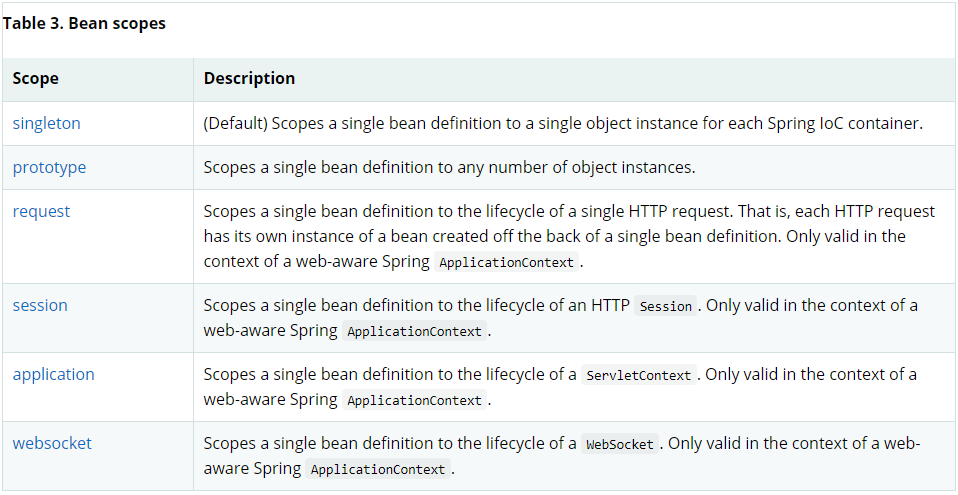
单例模式(spring 的默认模式)
<!-- the following is equivalent, though redundant (singleton scope is the default) --> <bean id="accountService" class="com.something.DefaultAccountService" scope="singleton"/>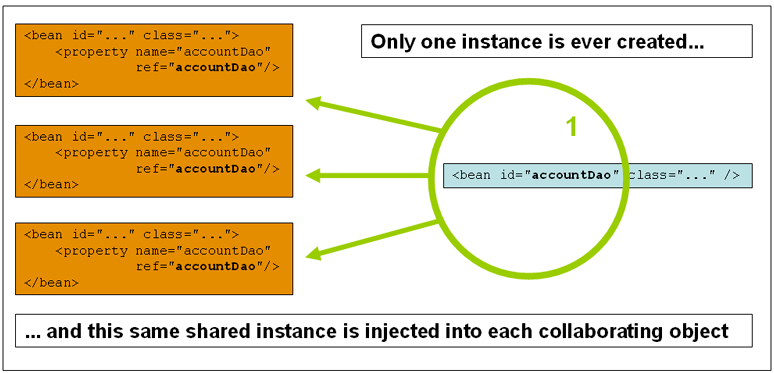
原型模式:每次从容器 get 的时候,都会产生一个新的对象
<bean id="accountService" class="com.something.DefaultAccountService" scope="prototype"/>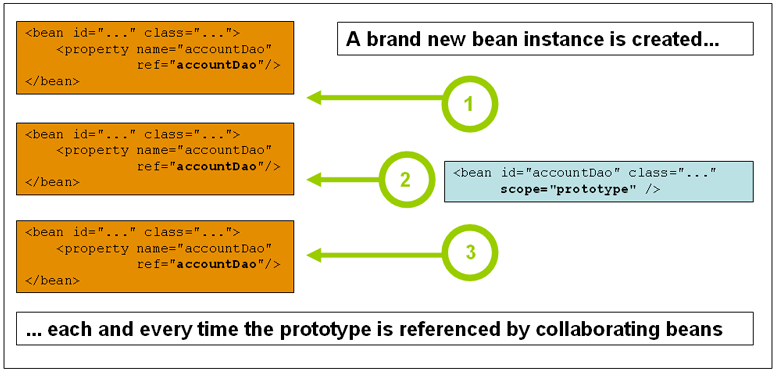
其余的
request,session,applicatoin这些只能在 web 开发中使用!
7、Bean 的自动装配
- 自动装配是 Spring 满足 bean 依赖的一种方式
- Spring 会在上下文中自动寻找,并自动给 bean 装配属性
在 Spring 中有三种装配方式
- 在 xml 中显示的配置
- 在 java 中显示配置
- 隐式的自动装配 bean
7.1、ByName 自动装配
<bean id="cat" class="com.kuang.pojo.Cat"></bean>
<bean id="dog" class="com.kuang.pojo.Dog"></bean>
<!--
byName:会自动在容器中上下文查找,和自己对象set方法后面的值对应的beanid
-->
<bean id="perple" class="com.kuang.pojo.People" autowire="byName">
<property name="name" value="saber"/>
</bean>7.2、ByType 自动装配
<bean id="cat" class="com.kuang.pojo.Cat"></bean>
<bean id="dog" class="com.kuang.pojo.Dog"></bean>
<!--
byType:会自动在容器中上下文查找,和自己对象属性类型相同的bean,
-->
<bean id="perple" class="com.kuang.pojo.People" autowire="byType">
<property name="name" value="saber"/>
</bean>小结:
- byname 的时候,需要保证所有 bean 的 id 唯一,并且这个 bean 需要和自动注入的属性的 set 方法的值一致
- bytype 的时候,需要保证所有 bean 的 class 唯一,并且这个 bean 需要和自动注入的属的类型一致
7.3、使用注解实现自动装配
jdk1.5 支持的注解,Spring2.5 就支持注解了
The introduction of annotation-based configuration raised the question of whether this approach is “better” than XML.
使用注解须知:
导入约束
配置注解的支持
<?xml version="1.0" encoding="UTF-8"?> <beans xmlns="http://www.springframework.org/schema/beans" xmlns:xsi="http://www.w3.org/2001/XMLSchema-instance" xmlns:context="http://www.springframework.org/schema/context" xsi:schemaLocation="http://www.springframework.org/schema/beans https://www.springframework.org/schema/beans/spring-beans.xsd http://www.springframework.org/schema/context https://www.springframework.org/schema/context/spring-context.xsd"> <context:annotation-config/> </beans>
@Autowired
直接在属性上使用即可,也可以在 set 方法使用
使用 Autowired 我们可以不用编写 Set 方法,前提是你这个自动装配的属性在 IOC(Spring)容器中存在,且符合名字 byname
@Autowired 默认根据类型进行匹配,若 xml 中同时存在多个相同类型时,则按名称进行匹配,若没用相同名称的配置时,则需要使用@Qualifier(value = “name”)注解进行指定,同时@Autowired 中还存在 required 属性,默认为 true,若为 false 时,说明对象可以为 null,否则不允许为空
<bean id="cat" class="com.kuang.pojo.Cat"></bean>
<!-- <bean id="dog" class="com.kuang.pojo.Dog"></bean>-->
<bean id="dog2" class="com.kuang.pojo.Dog"></bean>
<bean id="dog22" class="com.kuang.pojo.Dog"></bean>
<bean id="perple" class="com.kuang.pojo.People">
<property name="name" value="saber"/>
</bean>@Autowired
private Cat cat;
@Autowired
@Qualifier(value = "dog22")
private Dog dog;
private String name;@Resource
@Resource(name = "cat22")
private Cat cat;
@Resource
private Dog dog;小结:
@Resource 和@Autowired 的区别:
- 都是用于自动装配,都可以放在字段上
- @Autowired 通过 bytype 的方式实现,而且对象必须存在
- @Resource 默认通过 byname 实现,如果找不到名字,则通过 bytyoe 实现,如果两个都找不到,则报错
8、使用注解开发
<!--注意:需要引入AOP包-->
<!--需要扫描的包-->
<context:component-scan base-package="com.kuang.pojo"/>
<context:annotation-config/>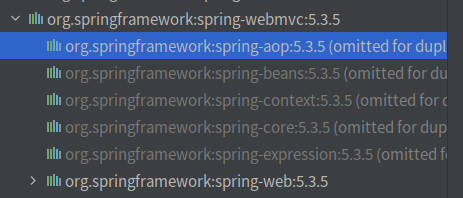
@Component 组件
//等价于<bean id="user" class="com.kuang.pojo.User"/> 无须在xml中写
@Component
public class User {
public String name="saber";
}@Value
@Component
public class User {
//等价于 <property name="name" value="saber"/>
@Value("SABER")
public String name;
}@Component 衍生注解,根据不同的层使用不同的注解
- dao 层【@Repository】
- service 层【@Service】
- controller 层【@Controller】
这四个注解功能都是一样的,都代表将某个类注册到 Spring 中,装配 Bean
作用域也可以直接通过@Scope("")实现
小结:
xml 与注解:
- xml 更加万能,适用于各种场合,维护简单
- 注解不是自己类使用不了,维护相对复杂
xml 与注解的最佳实践:
xml 来管理 bean
注解只负责完成属性的注入
我们使用中,只需要注意一个问题:必须让注解生效,就需要开启注解的支持
<!--需要扫描的包--> <context:component-scan base-package="com.kuang"/> <context:annotation-config/>
9、使用 Java 的方式配置 Spring
JavaConfig 是 Spring 的一个子项目
实体类:
package com.kuang.pojo;
import org.springframework.beans.factory.annotation.Value;
import org.springframework.stereotype.Component;
//@Component
public class User {
@Value("saber")
private String name;
public String getName() {
return name;
}
public void setName(String name) {
this.name = name;
}
@Override
public String toString() {
return "User{" +
"name='" + name + '\'' +
'}';
}
}
配置文件类:
package com.kuang.config;
import com.kuang.pojo.User;
import org.springframework.context.annotation.Bean;
import org.springframework.context.annotation.ComponentScan;
import org.springframework.context.annotation.Configuration;
//这个也会被Spring容器托管,注册到容器中,因为它本身就是一个@Component
//@Configuration表示这是一个配置类,就是之前的beans.xml
@Configuration
//@ComponentScan("com.kuang.pojo") //扫描指定包
@Import(SaberConfig2.class) //相当于Import标签
public class SaberConfig {
//注册一个bean 相当于之前的<bean>标签
//方法名相当于bean标签的id
//返回值相当于bean标签的class属性
@Bean
public User getUser(){
return new User();//我们要注入到bean的对象
}
}
//如果你没用扫描指定包@ComponentScan("com.kuang.pojo") 则必须使用@Bean主动进行配置,
//如果使用@ComponentScan("com.kuang.pojo")扫描,则扫描对象必须包含@Component测试方法:
public static void main(String[] args) {
ApplicationContext ctx = new AnnotationConfigApplicationContext(SaberConfig.class);
User user = ctx.getBean(User.class);//也可以用方法名getUser,也可以用@Bean指定的名称
System.out.println(user.getName());
}10、代理模式
代理模式的分类:
- 静态代理
- 动态代理
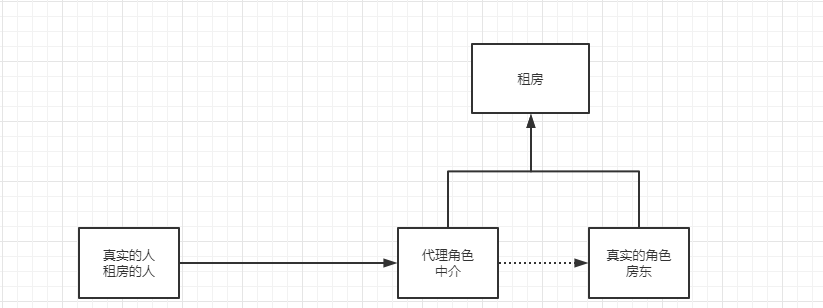
10.1、静态代理
角色分析:
- 抽象角色:一般会使用接口或抽象类来解决
- 真实角色:被代理的角色
- 代理角色:代理真实角色,代理真实角色后,我们一般会做一些附属操作
- 客户:访问代理对象
代码步骤:
接口
//租房 public interface Rent { public void rent(); }真实角色
public class Host implements Rent{ @Override public void rent() { System.out.println("房东要租房子"); } }代理角色
public class Proxy implements Rent{ private Host host; public Proxy() { } public Proxy(Host host) { this.host = host; } @Override public void rent() { seeHouse(); host.rent(); hetong(); fare(); } public void seeHouse(){ System.out.println("kan fang"); } public void hetong(){ System.out.println("qian he tong"); } public void fare(){ System.out.println("shou zhong jie fei"); } }客户端访问代理角色
public static void main(String[] args) { Host host = new Host(); // host.rent(); Proxy proxy = new Proxy(host); proxy.rent(); }
代理模式的好处:
- 可以使真实角色的操作更加纯粹,不用去关注一些公共服务
- 公共服务交给代理角色,实现业务划分
- 公共业务发生扩展时,方便集中管理
缺点:
- 一个真实角色就会产生一个代理角色,代码量翻倍,开发效率变低
10.2、动态代理
- 动态代理和静态代理角色一样
- 动态代理的代理类是动态生成的,不是写好的
- 动态代理分为两大类:基于接口的动态代理,基于类的动态代理
- 基于接口:JDK 实现动态代理
- 基于类:cglib
- java 字节码实现:javasist
需要了解两个类:Proxy:代理, InvocationHandler:调用处理程序
动态代理的好处:
- 可以使真实角色的操作更加纯粹,不用去关注一些公共服务
- 公共服务交给代理角色,实现业务划分
- 公共业务发生扩展时,方便集中管理
- 一个动态代理类代理的是一个接口,一般是对应的一类业务
- 一个动态代理类可以代理多个类,只要实现了同一个接口即可
动态代理的代码实现:
import java.lang.reflect.InvocationHandler;
import java.lang.reflect.Method;
import java.lang.reflect.Proxy;
public class StarProxy implements InvocationHandler
{
// 目标类,也就是被代理对象
private Object target;
public void setTarget(Object target)
{
this.target = target;
}
@Override
public Object invoke(Object proxy, Method method, Object[] args) throws Throwable
{
// 这里可以做增强
System.out.println("收钱");
Object result = method.invoke(target, args);
return result;
}
// 生成代理类
public Object CreatProxyedObj()
{
return Proxy.newProxyInstance(target.getClass().getClassLoader(), target.getClass().getInterfaces(), this);
}
}11、AOP
11.1、什么是 AOP
AOP(Aspect Oriented Programming)称为面向切面编程,在程序开发中主要用来解决一些系统层面上的问题,比如日志,事务,权限等待,AOP 是 OOP 的延续,是软件开发中的热点,是函数是编程的一种衍生范型,利用 AOP 可以对业务逻辑的各部分进行隔离,从而使业务逻辑各部分之间的耦合降低,提高可重用性。
11.2、AOP 在 Spring 的作用
提供声明性事务,允许用户自定义切面
- 横切关注点:跨越应用程序多个模块的方法或功能,即是,与我们业务逻辑无关,但是我们需要关注的部分,就是横切关注点,如日志,安全,缓存,事务等等….
- 切面(ASPECT):横切关注点 被模块化 的特殊对象。即,它是一个类。
- 通知(Advice):切面必须要完成的工作。即,它是类中的一个方法。
- 目标(Target):被通知的对象。
- 代理(Proxy):向目标对象应用通知之后创建的对象
- 切入点(PointCut):切面通知 执行的“地点”的定义
- 连接点(JointPoint):与切入点匹配的执行点
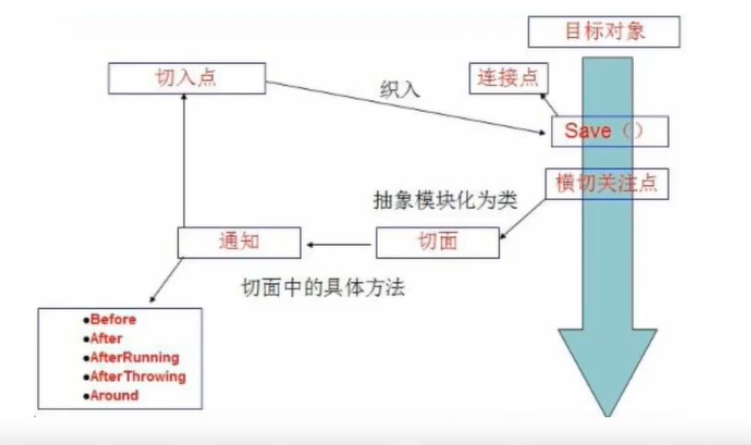
SpringAOP 中,通过 Advice 定义横切逻辑,Spring 中支持 5 种类型的 Advice:
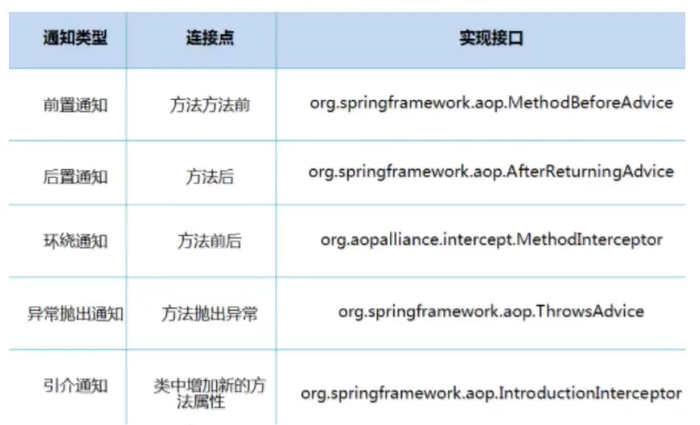
即 AOP 在不改变原有代码的情况下,去增加新的功能
11.3、使用 Spring 实现 AOP
使用 AOP 织入,需要导入一个依赖包
<dependency>
<groupId>org.aspectj</groupId>
<artifactId>aspectjweaver</artifactId>
<version>1.9.4</version>
</dependency>方法一:使用 Spring 接口
@Component
public class Log implements MethodBeforeAdvice {
//method:要执行的目标对象的方法
//objects:参数
//o:目标对象
@Override
public void before(Method method, Object[] objects, Object o) throws Throwable {
System.out.println(o.getClass().getName() +"的"+method.getName()+"方法被执行");
}
}@Component
public class AfterLog implements AfterReturningAdvice {
//returnValue:返回值
@Override
public void afterReturning(Object returnValue, Method method, Object[] args, Object target) throws Throwable {
System.out.println("执行了"+method.getName() +"方法,返回结果:"+returnValue);
}
}上面实现两个测试用的切面方法
<?xml version="1.0" encoding="UTF-8"?>
<beans xmlns="http://www.springframework.org/schema/beans"
xmlns:xsi="http://www.w3.org/2001/XMLSchema-instance"
xmlns:context="http://www.springframework.org/schema/context"
xmlns:aop="http://www.springframework.org/schema/aop"
xsi:schemaLocation="http://www.springframework.org/schema/beans
https://www.springframework.org/schema/beans/spring-beans.xsd
http://www.springframework.org/schema/context
https://www.springframework.org/schema/context/spring-context.xsd
http://www.springframework.org/schema/aop
https://www.springframework.org/schema/aop/spring-aop.xsd">
<context:component-scan base-package="com.kuang"/>
<context:annotation-config/>
<!--方法一:使用原生SpringAPI接口-->
<!--配置aop:需要导入aop约束-->
<aop:config>
<!--DOTO:切入点:expression:表达式,execution(要执行的位置!)-->
<aop:pointcut id="pointuct" expression="execution(* com.kuang.service.UserServiceImpl.*(..))"/>
<!--要执行的环绕增加-->
<aop:advisor advice-ref="afterLog" pointcut-ref="pointuct"/>
<aop:advisor advice-ref="log" pointcut-ref="pointuct"/>
</aop:config>
</beans>public class MyTest {
public static void main(String[] args) {
ApplicationContext context = new ClassPathXmlApplicationContext("applicationContext.xml");
UserService userService = context.getBean("userServiceImpl",UserService.class);
userService.add();
}
}方法二:自定义类实现 AOP
将配置文件修改为:
<?xml version="1.0" encoding="UTF-8"?>
<beans xmlns="http://www.springframework.org/schema/beans"
xmlns:xsi="http://www.w3.org/2001/XMLSchema-instance"
xmlns:context="http://www.springframework.org/schema/context"
xmlns:aop="http://www.springframework.org/schema/aop"
xsi:schemaLocation="http://www.springframework.org/schema/beans
https://www.springframework.org/schema/beans/spring-beans.xsd
http://www.springframework.org/schema/context
https://www.springframework.org/schema/context/spring-context.xsd
http://www.springframework.org/schema/aop
https://www.springframework.org/schema/aop/spring-aop.xsd">
<context:component-scan base-package="com.kuang"/>
<context:annotation-config/>
<!--方法二:自定义类-->
<aop:config>
<!--自定义切面,ref要引用的类-->
<aop:aspect ref="diyPintCut">
<!--切入点-->
<aop:pointcut id="point" expression="execution(* com.kuang.service.UserServiceImpl.*(..))"/>
<!--通知-->
<aop:after method="after" pointcut-ref="point"/>
<aop:before method="before" pointcut-ref="point"/>
</aop:aspect>
</aop:config>
</beans>实现的自定义类:
import org.springframework.stereotype.Component;
@Component
public class DiyPintCut {
public void before(){
System.out.println("=======berfre========");
}
public void after(){
System.out.println("=======after========");
}
}方式三:使用注解实现
import org.aspectj.lang.ProceedingJoinPoint;
import org.aspectj.lang.annotation.After;
import org.aspectj.lang.annotation.Around;
import org.aspectj.lang.annotation.Aspect;
import org.aspectj.lang.annotation.Before;
import org.springframework.stereotype.Component;
@Aspect //标注这是一个切面
@Component
public class AnnotationPointCut {
@Before("execution(* com.kuang.service.UserServiceImpl.*(..))")//注意 这是annotation包下的注解
public void before() {
System.out.println("=======berfre========");
}
@After("execution(* com.kuang.service.UserServiceImpl.*(..))")
public void after() {
System.out.println("=======after========");
}
//在环绕增强中,我们可以定一个参数,代表我们要获取处理的切入点
@Around("execution(* com.kuang.service.UserServiceImpl.*(..))")
public void around(ProceedingJoinPoint jp) throws Throwable {
System.out.println("before-around");
System.out.println(jp.getSignature());//获取签名
Object proceed = jp.proceed();//执行方法 proceed:返回值
System.out.println("after-around");
System.out.println(proceed);
}
}<?xml version="1.0" encoding="UTF-8"?>
<beans xmlns="http://www.springframework.org/schema/beans"
xmlns:xsi="http://www.w3.org/2001/XMLSchema-instance"
xmlns:context="http://www.springframework.org/schema/context"
xmlns:aop="http://www.springframework.org/schema/aop"
xsi:schemaLocation="http://www.springframework.org/schema/beans
https://www.springframework.org/schema/beans/spring-beans.xsd
http://www.springframework.org/schema/context
https://www.springframework.org/schema/context/spring-context.xsd
http://www.springframework.org/schema/aop
https://www.springframework.org/schema/aop/spring-aop.xsd">
<context:component-scan base-package="com.kuang"/>
<context:annotation-config/>
<!--开启注解支持 需要添加这个才能使用注解AOP-->
<!--有一个参数 默认为false 则为使用JDK实现动态代理 true则使用cglib proxy-target-class="true"-->
<aop:aspectj-autoproxy/>
</beans>参考: